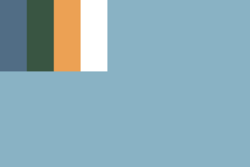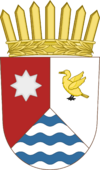Flag and coat of arms of Freice
 | |
| Use | Civil and state flag, civil and state ensign |
|---|---|
| Proportion | 2:3 (1.5) |
| Adopted | 1 August 1969 |
| Design | A light blue field with a rectangle on the upper hoist-side corner bearing the colours blue, green, orange, and white in vertical bars. |
| Designed by | Naaurilo Tavunisa |
| Coat of arms of Freice | |
|---|---|
 | |
| Versions | |
 Coat of arms of Freice for federal use | |
| Armiger | Diana II in Right of Freice |
| Adopted | 1 August 1969 |
| Crest | Maaita's Crown Proper |
| Blazon | Party per pall inverted, 1st Gules a star 2nd Argent a bird Or 3rd per fess barry wavy Azure and Argent |
| Supporters | Cranes holding the national flag of Freice |
| Motto | KALAA ATA LAVAAE Separate and Free |
The flag and the emblem of Freice are the state symbols of Freice, a country of the Riamese Federation. The symbols were adopted by the Representative Council in 1969 and were formally sanctioned for use by King Frederick on 1 August 1969.
The flag is a public symbol and there are few restrictions on its use.[a] The emblem is used to represent the government and may not be used in a private or commercial capacity.
Flag
Until 1969, Freice had no flag of its own and used the Riamese flag. Attempts to establish a distinctive Freician flag began in the 1910s but achieved greater motion in the 1940s. Disagreements on the exact nature of the flag, whether reference to Riamo should be made, and its exact legal status. The Representative Council eventually agreed on a design by artist Naaurilo Tavunisa, presenting a petition to King Frederick to proclaim the design. On 1 August 1969, the King issued a formal proclamation recognising the flag and permitting its use.
The flag of Freice is a sky blue banner, with its width double that of its length. The colour represents the sky - recalling both the importance of the stars in navigation and the traditionally-held belief that all Freicians were "united under the sky blue". Additionally, the colour blue holds important symbolic meaning in Kaldaic culture, representing trustworthiness, honesty, and loyalty. In the charge are the four traditional Kaldaic colours - dark blue, dark green, gold, and white. These colours have long been associated with Kaldaic culture and have a number of different meanings based on the particular circumstances of their use. However, the colours are generally attributed the following meanings:<
- dark blue: the importance of the sea in securing the necessities of life
- dark green: the natural environment and the symbiotic relationship between man and nature
- gold: the divinity of God and the presence of God in all people
- white: the peacefulness of the people and the purity of their intents
Coat of arms
The coat of arms of Freice depicts a taanaka, a shield traditionally used by the highest noble class in official state ceremonies. The shield is quartered into three sections; in the first a star on a red field, the second a golden bird on a white field, and the third blue waves. The shield is supported by two cranes, each holding the national flag from a pole. The crest is the heraldic Maaita's Crown. The island's motto appears in a white scroll. The emblem was established at the same time as the national flag.
The emblem takes inspiration from the federal school of Riamese heraldry. It features as its central element a traditional Freician qaba shield divided into three quarters. In the first quarter is a white star, called the Kaldaz Star, on a red field, which is a traditional symbol of Freice. It is said that the Kaldaz Star would guide fisherman to fish and then back to land, offering good luck and safety. In the second quarter is a golden bird on a white field, a reference to the mythical story of a "bird of pure gold" which came to the poor man at his time of need. In the third quarter are blue waves on a white field, representing the sea - from which Freice supposedly arose.
A variant for use in federal contexts was introduced in 1978. It features the blazon in a federal escutcheon crowned with the Maaita's Crown. This variant is used on federal car registration plates.
See also
Notes
- ↑ Under Riamese federal law, the copyright for the design is shared between the federal and island governments.
External links
